steering CADILLAC DEVILLE 1993 7.G User Guide
[x] Cancel search | Manufacturer: CADILLAC, Model Year: 1993, Model line: DEVILLE, Model: CADILLAC DEVILLE 1993 7.GPages: 406, PDF Size: 20.78 MB
Page 104 of 406
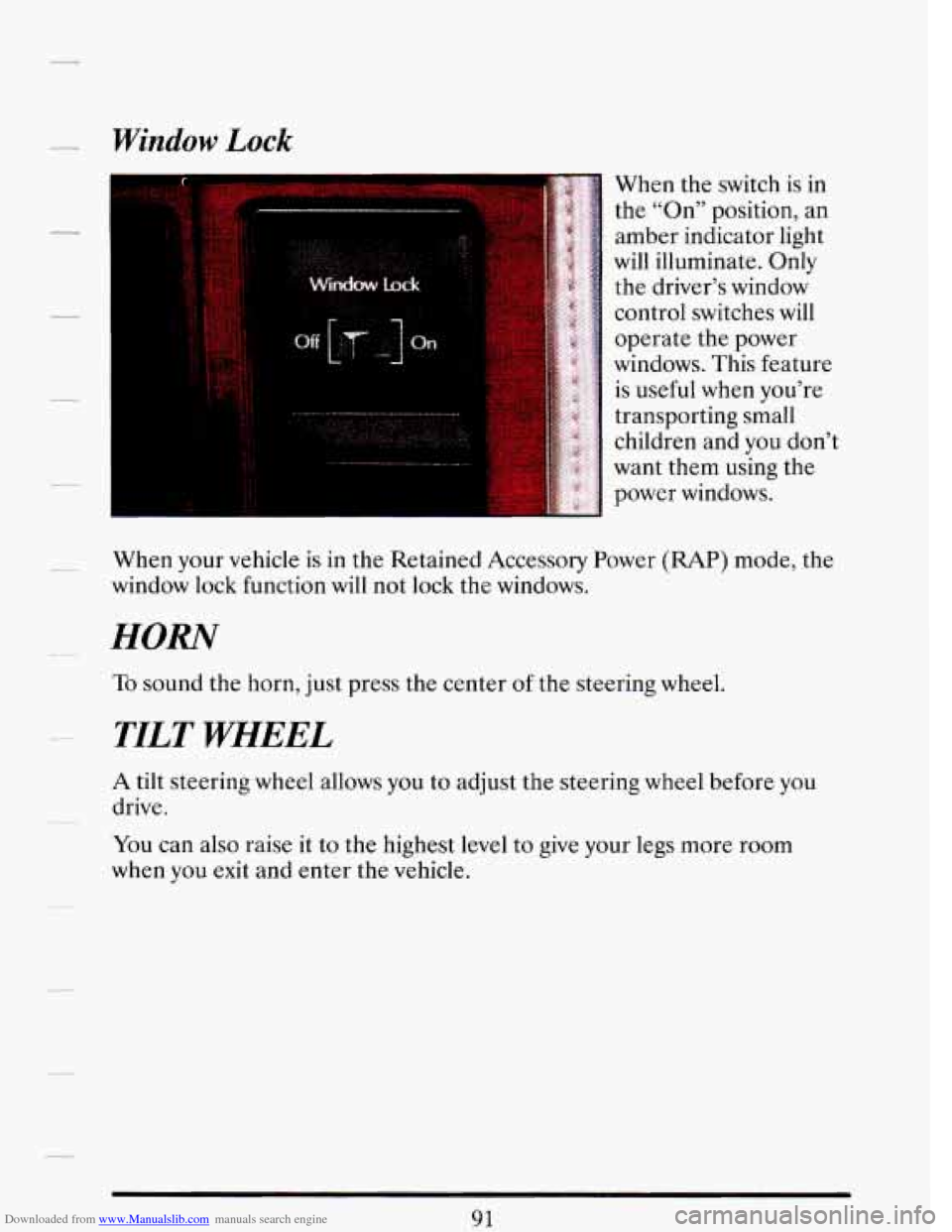
Downloaded from www.Manualslib.com manuals search engine Window Lock
When the switch is in
the "On" position, an
amber indicator light
will illuminate.
Only
the driver's window
control switches will
operate the power
windows. This feature
~ is useful when you're
transporting small
children and you don't
want them using the
power windows.
When your vehicle is in the Retained Accessory Power
(RAP) mode, the
window lock function will not lock the windows.
HORN
To sound the horn, just press the center of the steering wheel.
TILT WHEEL
A tilt steering wheel allows you to adjust the steering wheel before you
drive.
You can also raise it to the highest level to give your legs more room
when you exit and enter the vehicle.
Page 105 of 406
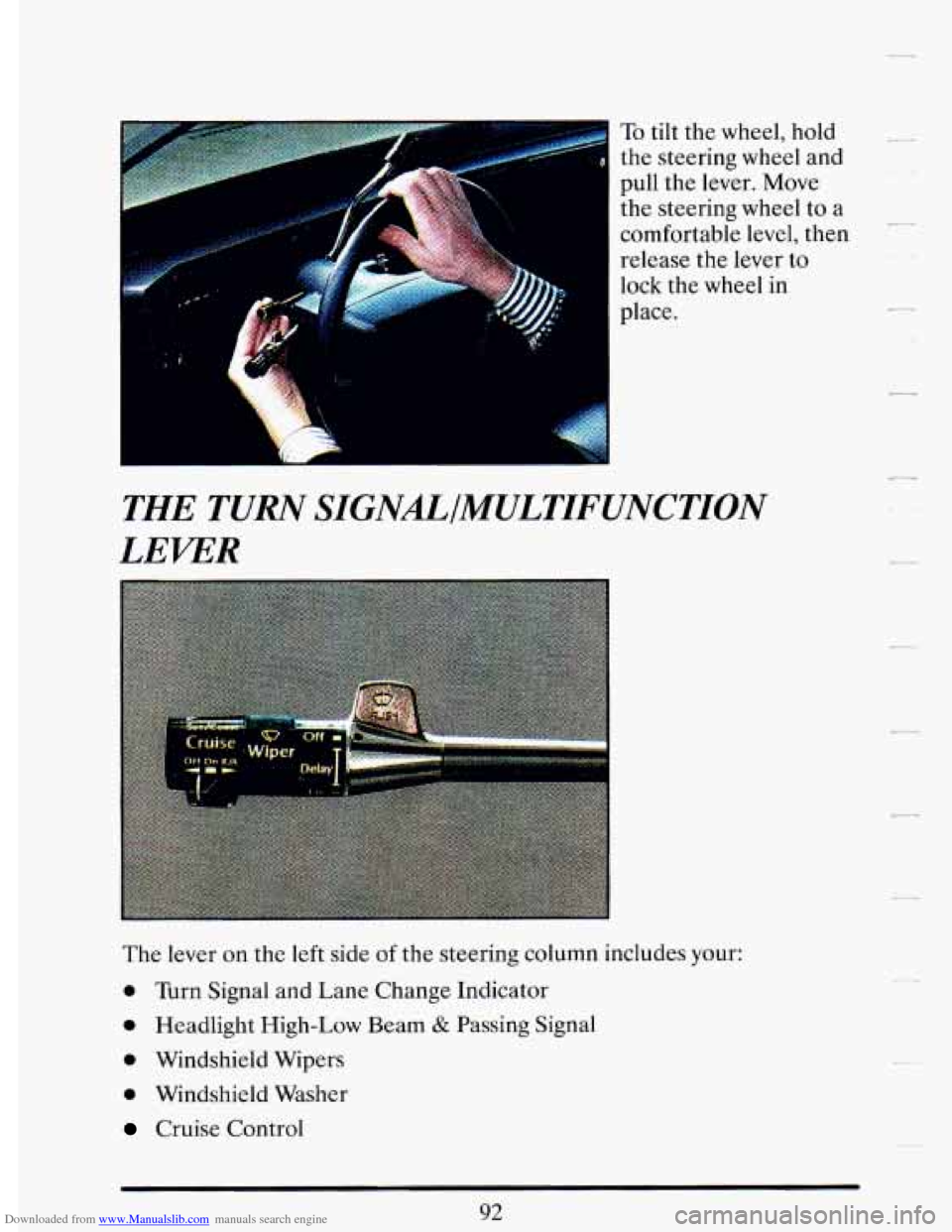
Downloaded from www.Manualslib.com manuals search engine To tilt the wheel, hold -
the steering wheel and b.
pull the lever. Move
the steering wheel to a
comfortable level, then
release the lever to
lock the wheel in
place.
-
THE TURN SIGNK/MULTIFUNCTION
LEVER
The lever on the left side of the steering column includes your:
0 Turn Signal and Lane Change Indicator
0 Headlight High-Low Beam & Passing Signal
0 Windshield Wipers
0 Windshield Washer
Cruise Control
92
Page 142 of 406
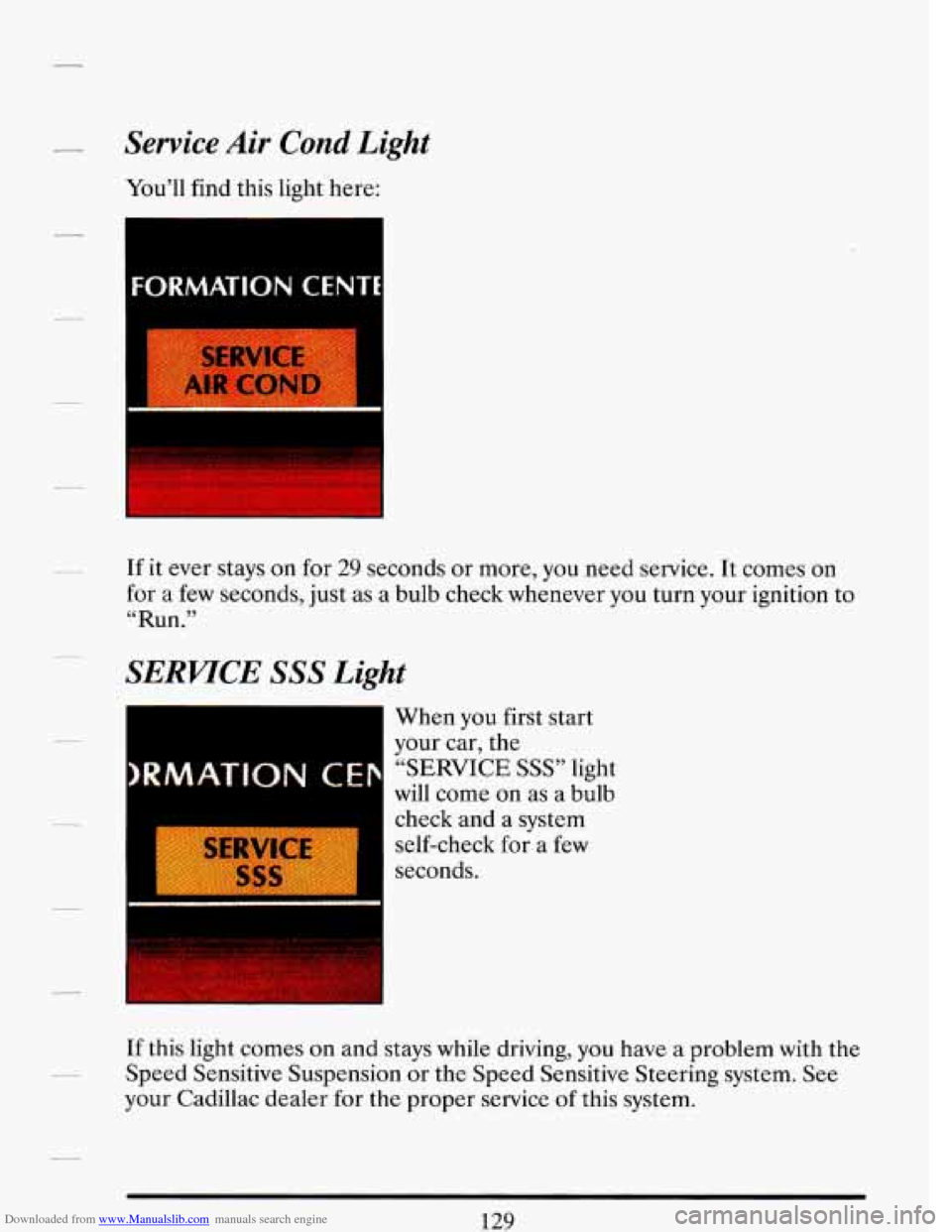
Downloaded from www.Manualslib.com manuals search engine - Service Air Cond Light
You’ll find this light here:
FORMATION CENTE
iERVICE
__ If it ever stays on for 29 seconds or more, you need service. It comes on
for a few seconds, just as a bulb check whenever you turn your ignition to
“ Run. ”
__
SERWCE SSS Light
bRMATION CEP
When you first start
your car, the
“SERVICE SSS” light
will come on as a bulb
check and a system
self-check for a
few
seconds.
If this light comes
on and stays while driving, you have a problem with the
Speed Sensitive Suspension or the Speed Sensitive Steering system. See
your Cadillac dealer for the proper service
of this system.
129
Page 148 of 406
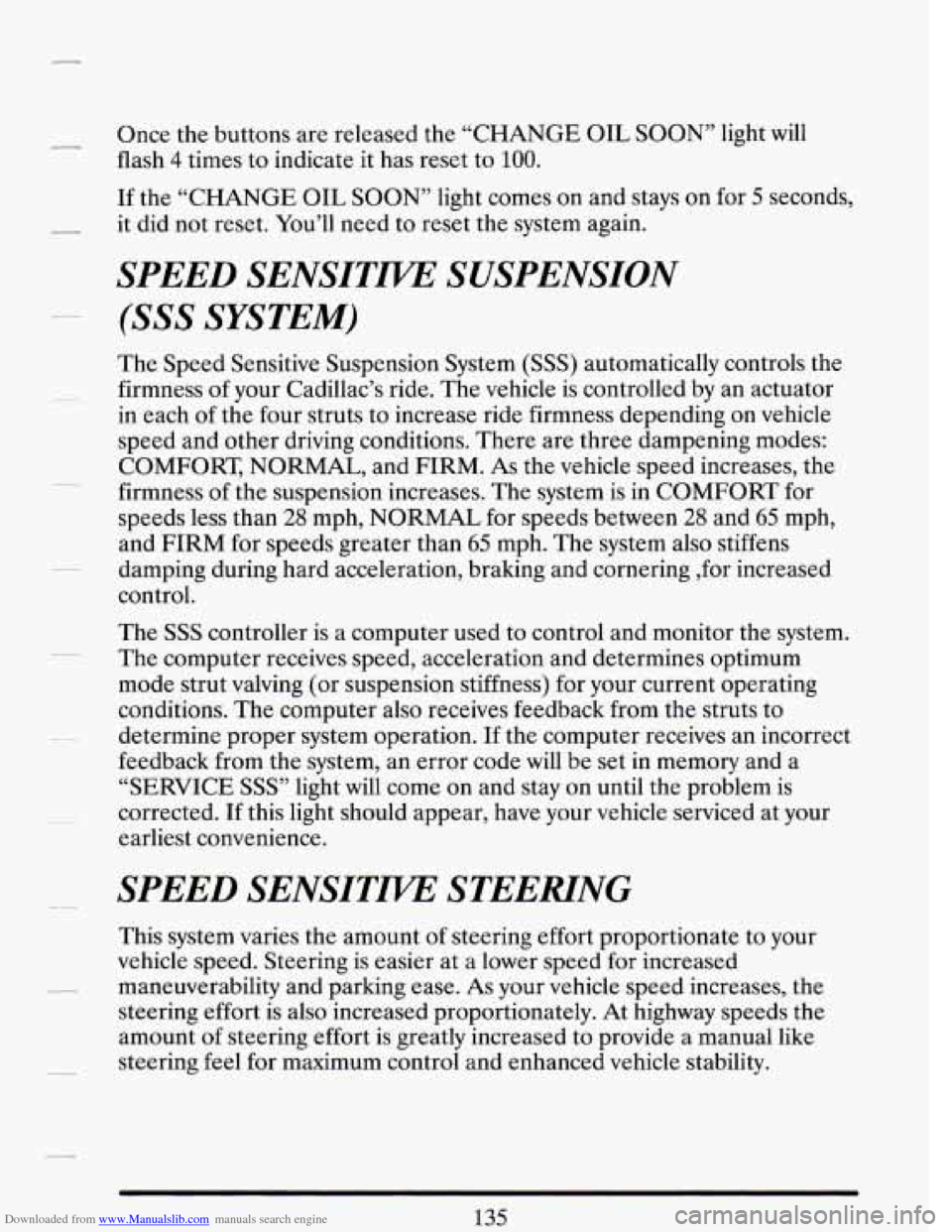
Downloaded from www.Manualslib.com manuals search engine Once the buttons are released the “CHANGE OIL SOON” light will
flash 4 times to indicate it has reset to
100.
If the “CHANGE OIL SOON” light comes on and stays on for 5 seconds,
it did not reset. You’ll need to reset the system again.
SPEED SENSITIVE SUSPENSION
(SSS SYSTEM)
The Speed Sensitive Suspension System (SSS) automatically controls the
firmness of your Cadillac’s ride. The vehicle is controlled by an actuator
in each of the four struts to increase ride firmness depending on vehicle
speed and other driving conditions. There are three dampening modes:
COMFORT, NORMAL, and
FIRM. As the vehicle speed increases, the
firmness of the suspension increases. The system is in COMFORT for
speeds less than
28 mph, NORMAL for speeds between 28 and 65 mph,
and FIRM for speeds greater than
65 mph. The system also stiffens
damping during hard acceleration, braking and cornering ,for increased
control.
The SSS controller is a computer used to control and monitor the system.
The computer receives speed, acceleration and determines optimum
mode strut valving (or suspension stiffness) for your current operating
conditions. The computer also receives feedback from the struts to
determine proper system operation.
If the computer receives an incorrect
feedback from the system, an error code
will be set in memory and a
“SERVICE
SSS” light will come on and stay on until the problem is
corrected.
If this light should appear, have your vehicle serviced at your
earliest convenience.
SPEED SENSITm STEERING
This system varies the amount of steering effort proportionate to your
vehicle speed. Steering is easier at a lower speed for increased
maneuverability and parking ease. As your vehicle speed increases, the
steering effort is also increased proportionately. At highway speeds the
amount
of steering effort is greatly increased to provide a manual like
steering
feel for maximum control and enhanced vehicle stability.
135
Page 192 of 406
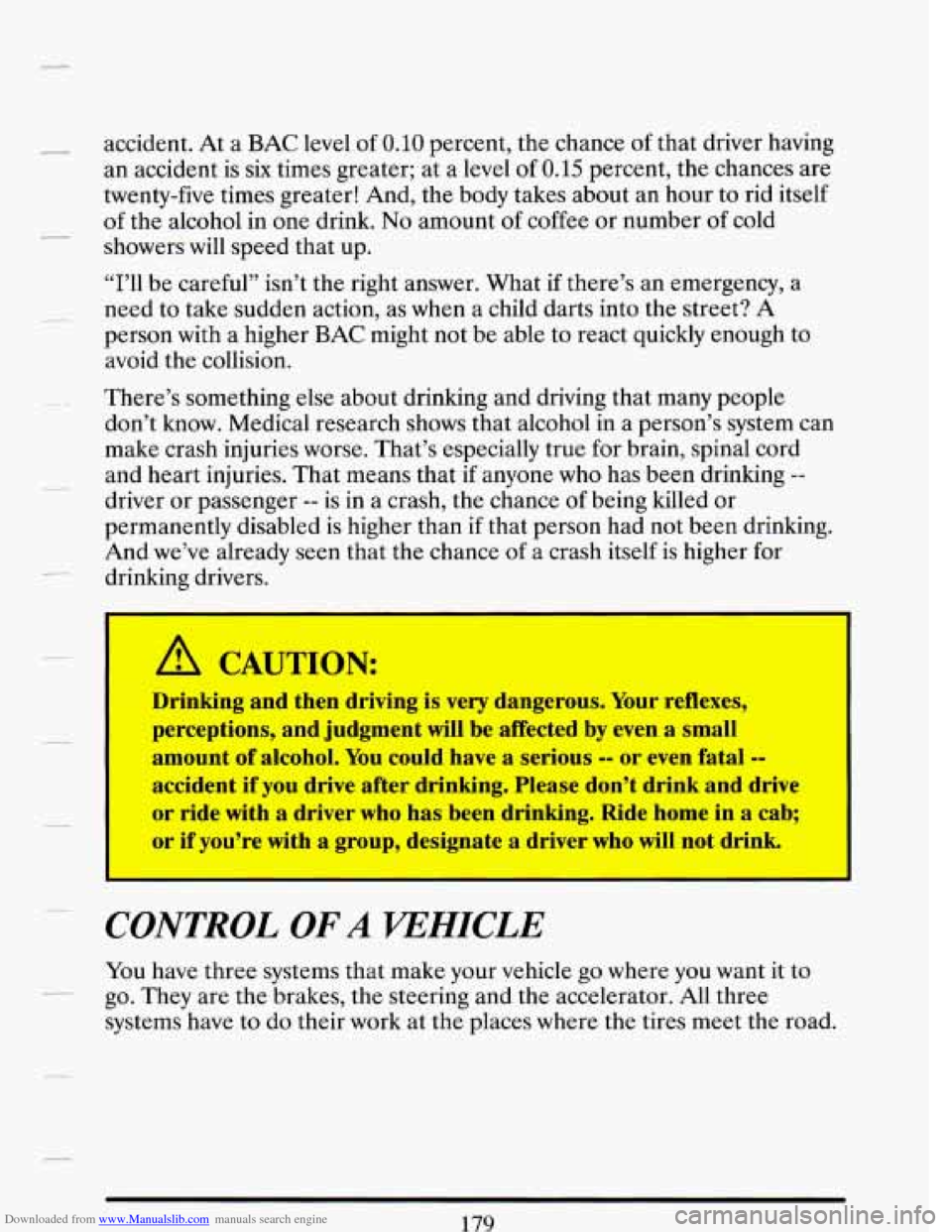
Downloaded from www.Manualslib.com manuals search engine - accident. At a BAC level of 0.10 percent, the chance of that driver having
an accident is
six times greater; at a level of 0.15 percent, the chances are
twenty-five times greater! And, the body takes about an hour to rid itself
of the alcohol in one drink. No amount of coffee or number of cold
showers will speed that up.
“I’ll be careful” isn’t the right answer. What
if there’s an emergency, a
person with a higher BAC might not be able to react quickly enough to
avoid the collision.
-
-_ need to take sudden action, as when a child darts into the street? A
-~ . There’s something else about drinking and driving that many people
don’t know. Medical research shows that alcohol in a person’s system can
make crash injuries worse. That’s especially true for brain, spinal cord
-- and heart injuries. That means that if anyone who has been drinking --
driver or passenger -- is in a crash, the chance of being killed or
permanently disabled is higher than if that person had not been drinking.
And we’ve already seen that the chance
of a crash itself is higher for
drinking drivers. -
* Drinking and then driving is very dangerous. Your reflexes,
perceptions, and judgment will be affected by even a small
amount of alcohol. You could have a serious -- or even fatal --
accident if you drive after drinking. Please don’t drink and drive
or ride with a driver who has been drinking. Ride home’in a cab;
or if you’re with a pup, designate a driver who will not drink
- CONTROL OF A WHICLE
You have three systems that make your vehicle go where you want it to
go. They are the brakes, the steering and the accelerator.
All three
systems have to do their work at the places where the tires meet the road. --
179
Page 199 of 406

Downloaded from www.Manualslib.com manuals search engine VOTICE:
Cmtinuing to drive with worn-out brake pads could result in
I
costly brake repair
Some driving conditions or climates may cause a brake squeal when the
brakes are first applied or lightly applied. This does not mean something
is wrong with your brakes.
Rear Drum Brakes
Your rear drum brakes don’t have wear indicators, but if you ever hear a
rear brake rubbing noise, have the rear brake linings inspected.
Also, the
rear brake drums should be removed and inspected each time the tires
are removed for rotation or changing. When
you have the front brakes
replaced, have the rear brakes inspected, too.
Brake linings should always be replaced as complete axle sets.
Brake Pedal Travel
See your dealer if the brake pedal does not return to normal height, or if
there is a rapid increase in pedal travel. This could be a sign of brake
trouble.
Brake Adjustment
Every time you make a moderate brake stop, your brakes adjust for wear.
If you rarely make a moderate or heavier stop, then your brakes might
not adjust correctly. If you drive in that way, then
-- very carefully -- make
a
few moderate brake stops about every 1000 miles (1600 km), so your
brakes will adjust properly.
Braking in Emergencies
Use your anti-lock braking system when you need to. With anti-lock, you
can steer and brake at the same time.
In many emergencies, steering can
help you more than
even the very best braking.
186
- i
c
r
Page 200 of 406
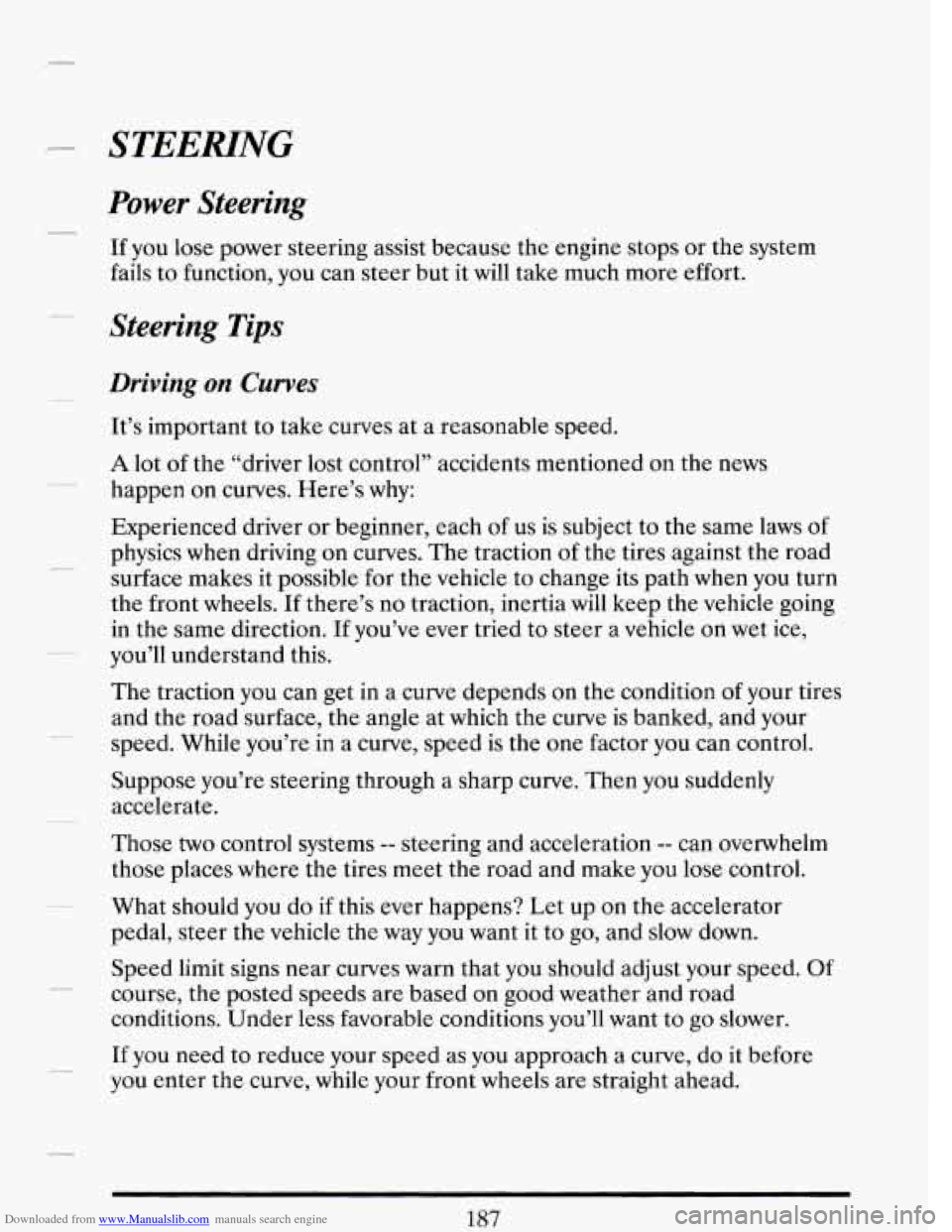
Downloaded from www.Manualslib.com manuals search engine Power Steering
If you lose power steering assist because the engine stops or the system
fails to function, you can steer but it will take much more effort.
Steering Tips
Driving on Curves
It’s important to take curves at a reasonable speed.
A lot of the “driver lost control” accidents mentioned on the news
happen on curves. Here’s why:
Experienced driver or beginner, each
of us is subject to the same laws of
physics when driving on curves. The traction of the tires against the road
surface makes it possible for the vehicle to change its path when you turn
the front wheels.
If there’s no traction, inertia will keep the vehicle going
in the same direction.
If you’ve ever tried to steer a vehicle on wet ice,
you’ll understand this.
__
The traction you can get in a curve depends on the condition of your tires
and the road surface, the angle at which the curve is banked, and your
speed. While you’re in a curve, speed is the one factor you can control.
Suppose you’re steering through a sharp curve. Then you suddenly
accelerate.
Those
two control systems -- steering and acceleration -- can overwhelm
those places where the tires meet the road and make you lose control.
What should you do if this ever happens? Let up on the accelerator
pedal, steer the vehicle the way you want it to go, and slow down.
Speed limit signs near curves warn that you should adjust your speed.
Of
course, the posted speeds are based on good weather and road
conditions. Under less favorable conditions you’ll want to go slower.
If you need to reduce your speed as you approach a curve, do it before
you enter the curve, while your front wheels are straight ahead.
Page 201 of 406

Downloaded from www.Manualslib.com manuals search engine Try to adjust your speed so you can “drive” through the curve. Maintain a
reasonable, steady speed. Wait to accelerate until you are out of
the
curve, and then accelerate gently into the straightaway.
When you drive into a curve at night, it’s harder to see the road ahead
of
you because it bends away from the straight beams of your lights. This is
one good reason to drive slower.
Steering in Emergencies
There are times when steering can be more effective than braking. For
example, you come over a hill and find a truck stopped in your lane, or a
car suddenly pulls out from nowhere, or a child darts out from between
parked cars and stops right in front of you. You can avoid these problems
by braking
-- if you can stop in time. But sometimes you can’t; there isn’t
room. That’s the time for evasive action
-- steering around the problem.
Your Cadillac can perform
very well in emergencies like these. First apply
your brakes. It is better to remove as much speed as you can from a
possible collision. Then steer around the problem, to the left or right
depending on the space available.
An emergency like this requires close attention and a quick decision. If
you are holding the steering wheel at the recommended 9 and 3 o’clock
positions, you can turn it a
full 180 degrees very quickly without removing
either hand. But you have to act fast, steer quickly, and just as quickly
straighten the wheel once you have avoided the object. You must then be
prepared to steer back to your original lane and then brake to a
controlled stop.
Depending on your speed, this can be rather violent for an unprepared
driver. This is one of the reasons driving experts recommend that you use
your safety belts and keep both hands on the steering wheel.
188
-‘ I
-
I cc
-.
r
)--r
-
LL
Page 202 of 406
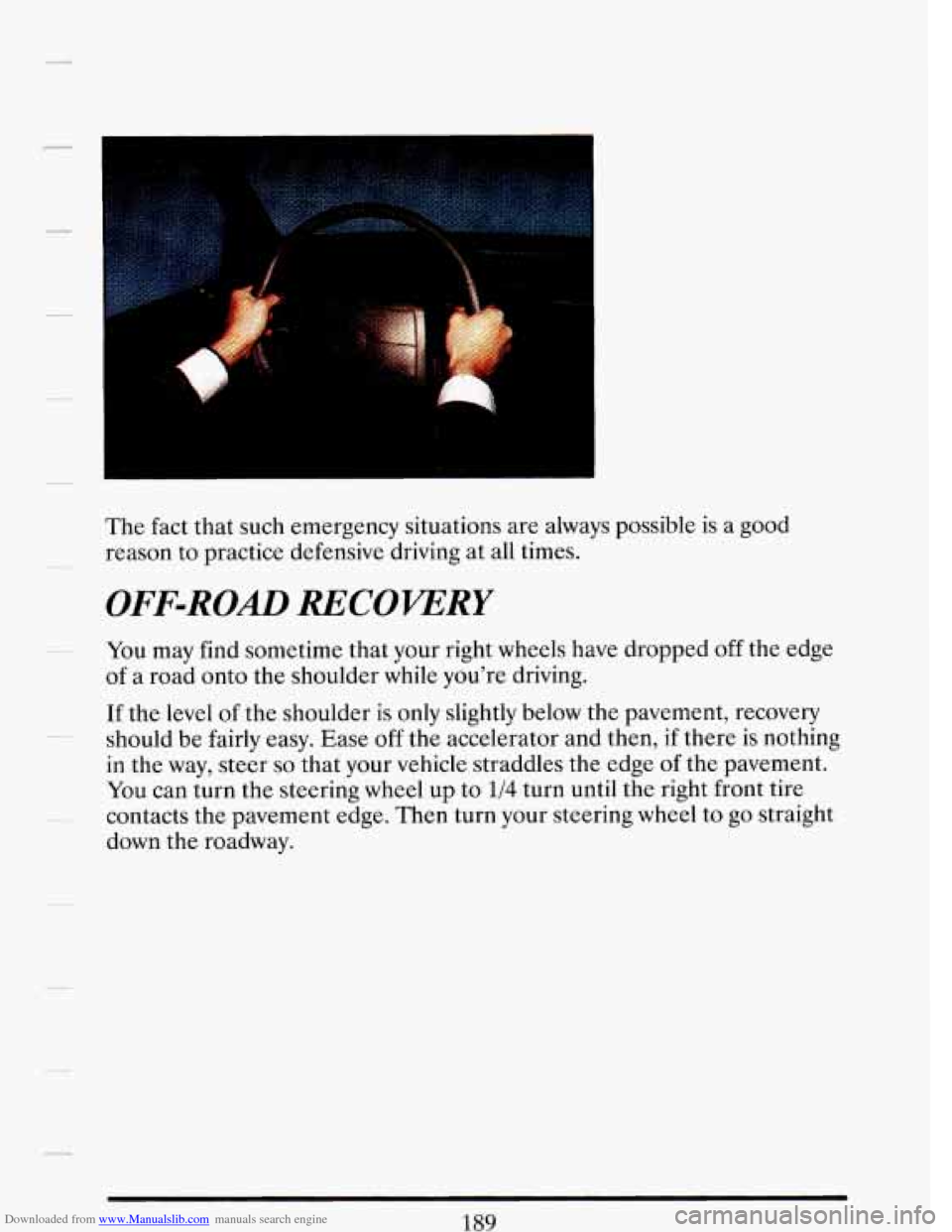
Downloaded from www.Manualslib.com manuals search engine The fact that such emergency situations are always possible is a good
reason to practice defensive driving at all times.
OFF-ROAD RECOVERY
You may find sometime that your right wheels have dropped off the edge
of a road onto the shoulder while you’re driving.
If the level of the shoulder is only slightly below the pavement, recovery
should be
fairly easy. Ease off the accelerator and then, if there is nothing
in the way, steer
so that your vehicle straddles the edge of the pavement.
You can turn the steering wheel up to 1/4 turn until the right front tire
contacts the pavement edge. Then turn your steering wheel to
go straight
down the roadway.
189
Page 203 of 406

Downloaded from www.Manualslib.com manuals search engine QCe ROAD RECOVER)
/ /
*- I
-I
7,
If the shoulder appears to be about four inches (100 mm) or more below
the pavement, this difference can cause problems.
If there is not enough
room to pull entirely onto the shoulder and stop, then follow the same
procedures. But if the right front tire scrubs against the side of the
pavement,
do NOT steer more sharply. With too much steering angle, the
vehicle may jump back onto the road with so much steering input that it
crosses over into the oncoming traffic before you can bring it back under
control.
r
L
_.
tr
Instead, ease off again on the accelerator and steering input, straddle the
pavement once more, then try again.
PASSING
The driver of a vehicle about to pass another on a two-lane highway waits
for just the right moment, accelerates, moves around the vehicle ahead,
then goes back into the right lane again.
A simple maneuver?
Not necessarily! Passing another vehicle on a two-lane highway
is a
potentially dangerous move, since the passing vehicle occupies the same
lane as oncoming traffic for several seconds.
A miscalculation, an error in
judgment, or a brief surrender
to frustration or anger can suddenly put
the passing driver face to face with the worst
of all traffic accidents -- the
head-on collision.
-
'L